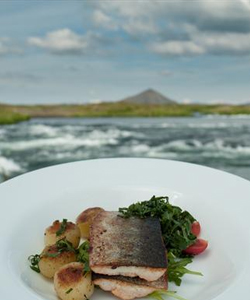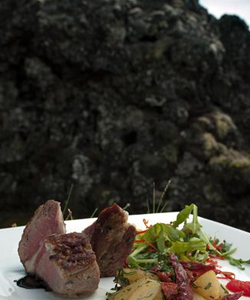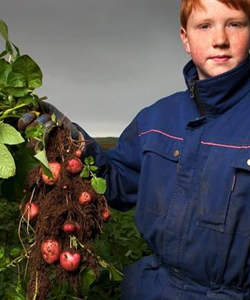
Eating and Drinking
One of people's main reasons for travelling is curiosity. Seeing something different, learning something new, experience the unknown, with all senses. That includes: tasting. Tasting Iceland is definitely an experience. Though sometimes only for the brave...
Traditional Icelandic food
If we look for traditional food in Iceland we have to look back in time, as far back as to the late 9th century, the time of the first settlers: the Vikings.
Iceland's not exactly a plants paradise (see also Fauna & Flora section [internal link]), even less so when it comes to edible plants. Apart from berries no fruits grow here, the number of native vegetables is zero. There is still a lot of mystery around the eating habits of the Vikings but it seems that they didn't grew anything. They grounded grains to flower and baked bread, this we know, but the grain may have been imported.
The Viking diet was almost entirely meat based: sheep and fish, some occasional birds and seals.
Apart from fish food was never plentiful. Ancient settlers couldn't afford to be picky, they had to eat whatever available. Speaking of animals that included head, balls, legs and intestines.
As often as cooked or grilled meat and fish were dried, pickled, smoked or fermented. Apart from adding variation to the menu these were essential preservation techniques to store food for rougher times. The winter, for instance.

Traditional Icelandic dishes today
Today's Icelandic dishes are the successors of the things the early settlers ate.
Maybe the most popular dish, that's to say the one Iceland has earned itself a certain fame for beyond its borders, is the "Hákarl" (pronounced "howkattl"): fermented shark. You get an idea of what it's about replacing the word "fermented" with "rotten".
Hákarl is made from the meat of the Greenland shark who happens to have no kidneys. Metabolic products like urea and trimethylamine oxide accumulate in its body making the (fresh) meat poisonous. Leaving it to rot and then to dry breaks down the poisonous substances. For this the shark is buried in the ground for 2-3 months then cut in stripes and put to dry during several more months. It is served in tiny squares.
What does it taste like?
Well, the Hákarl's main problem is not its taste but: it's smell. It smells of what it is: rotten fish. If you want to be brave and try it we recommend to put a piece in your mouth rapidly. DON'T SMELL! The taste is not as bad as the smell. Honestly. But still something to remember for the rest of your life. But then, isn't that what you came here for: lasting memories? :-)
Traditional as well are "Svið" (boiled sheep's head), "Harðfiskur" (dried (literally "hard") fish), "Súrmatur" (transl.: sour food, a variety of meat), "Rófustappa" (mashed beets), "Lifrarpylsa" (sheep liver sausage), "Síld" (pickled herring). All the just mentioned are combined with "Rúgbrauð" (rye bread) in the "Þorramatur", a dish served during the annual "Þorrablót", a feast in the honour of Thor (the ancient pagan god Þorr) lasting from mid-January to mid-February.
Then there is "hrútspungur", a sort of meat cake based on pickled sheep testicles.
A typical Christmas dish is "hangikjöt" (transl.: hanging meat), sheep meat, smoked for two days and often served together with mashed potatoes and beans.

Modern Icelandic cuisine
What is "traditional" is not necessarily "typical". All the above mentioned dishes, though “famous”, are not really part of the daily diet of a modern Icelander. Many of the dishes you can taste in the numerous excellent Icelandic restaurants,have their roots in the old recipes but are influenced by cuisines from around the world, adapted to the tastes of a post-Viking generation.
Fish
Salt and sweet water fishes are abundant in Icelandic waters. It's no wonder that they dominate the menus throughout the country in a great variety and extraordinary quality. Most common are salmon, trout and Arctic char. They come in variations like smoked salmon (“gravlax”) or “haddock”, salmon marinated with salt, sugar and a lot of dill. Likewise popular are fish balls ("fiskibollur") or chopped and fried fish ("steiktur fiskur í raspi").
A good place to sample those specialities is the weekend market in the Kolaporta building close to Reykjavik's harbour. There you can (apart from trying the fermented shark if you dare...) buy all variations of dried fish - a nice and convenient present to take back home to friends and family. Dried fish you can also buy in the super markets, by the way.

Meat
Iceland's most popular type of meat is "home grown" sheep.
The animals roam freely through the mountains during the summer months, happily nibbling away whatever edible plants is to be found. No hormones, no antibiotics - the quality of the meat is exquisite. Sheep is served smoked, grilled as the "Sunnudags lambasteik" (Sunday’s lamb steak), in form of patés and in other variations.

If sheep is not exotic enough for you, don't worry. What about tasting reindeer for example? The reindeer hunting season is from July to September but the meat is on offer on Icelandic menus year round.
Whale meat is also on offer in most Icelandic restaurants. Many say that taste and consistency of whale meat don't differ a lot from beef. A chef we know once put it this way: “Whale tastes like a cow which has been eating fish all her life.”
You best make up your own mind.
Also on offer in the “more exotic meat section” is seal and puffin. Puffin, yes, the funny bird with the big striped peak and red feet. Cooked on the plate it looses some of his charm. Admittedly.
Beside, there is all kind of international food available, most of all in Reykjavik and Akureyri, the biggest cities.
The most popular food among today's Icelanders is.: the hot dog ("pylsa"). You will find it everywhere, even in the most remote places on the countryside. Even some of the most frequented tourist sites now star a hot dog booth. Sightseeing makes hungry.
Skyr
Not a dish but evenly popular among locals is "Skyr". It is a dairy product often described as “a kind of yoghurt”. Tastewise it goes in the direction, productionwise it's got nothing to do (apart from the fact that it's made from milk). Skyr is a cheese, "curd cheese" to be precise (although the name usually doesn't ring a bell to anybody). It's the same as "Quark" in Germany, if that helps. Whatever it is, it is extremely tasty. It can be eaten plain but usually comes sweetened and fruit flavoured in all variations, in thick consistency to be eaten with a spoon or more liquid as a beverage. You can buy it almost everywhere, mostly in supermarkets.

Alcohol
Getting drunk in Iceland requires some planning. Like in other Scandinavian countries the sale of alcohol is subject to (some say annoying) restrictions. It can only be bought in dedicated shops, the so called "Vinbuð". They are closed at times where they are most needed: after 18h on week days and after 14 h on Saturdays throughout the entire weekend. Don't panic: bars and restaurants continue to sell alcohol beyond those times.

Getting drunk is not only made difficult by inconvenient opening hours but also (and maybe more so) by the prices. A glass of 0,5 l beer in a bar costs 5-6 Euro. If you find a bottle of decent wine in the supermarket for under 7 Euros you can consider yourself lucky. The high prices are due to the high tax rates. It may thus be a wise idea to provide yourself with alcohol upon arrival in the airport's duty free shop. Even if you don't want to drink yourself but you have friends living in Iceland: buy some for them. They will appreciate it.
A popular local alcoholic drink is "Brennivin", also referred to as "Black Death". It's a sort of brandy, high voltage alcohol made from potatoes and flavoured with caraway. Look out for the black label on the bottle.
Iceland also brews its own (surprisingly tasty) beer. Popular brands are Viking, Egil Gulls or Thule. Ingredients are imported, though.